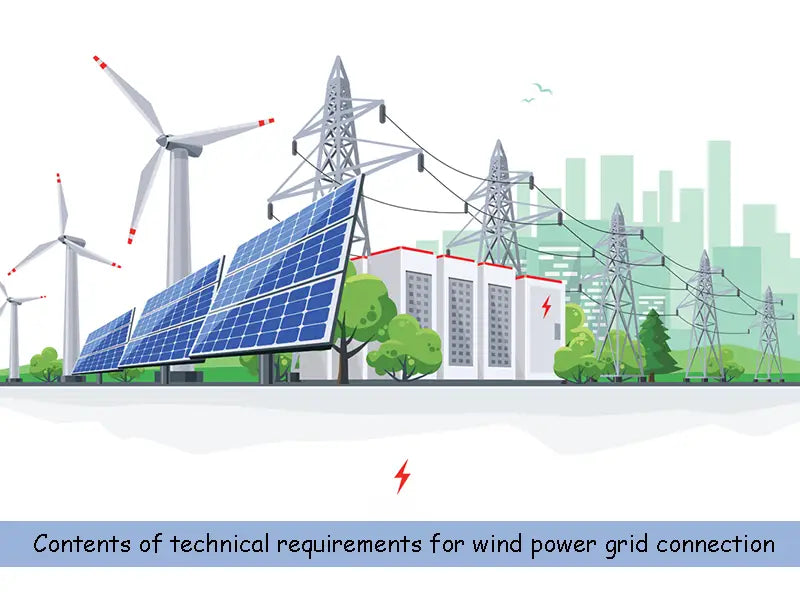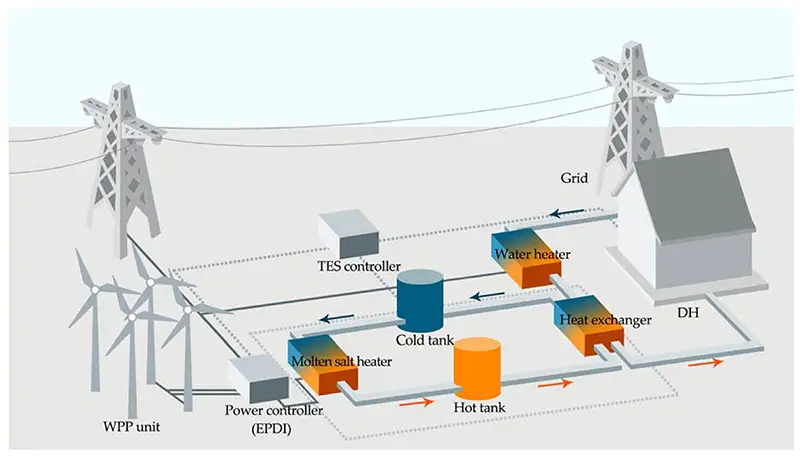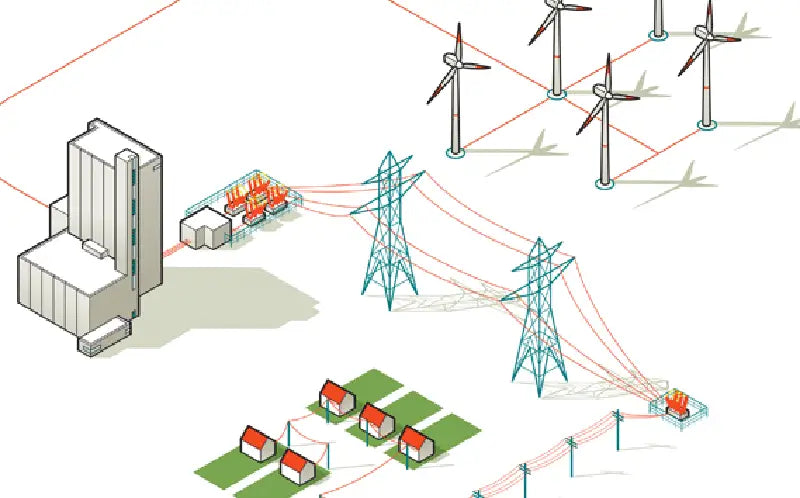
Main content:
- Voltage level of wind power grid connection technology and grid strengthening requirements
- Requirements for active power control of wind power grid connection wind farms
- Requirements for wind power grid connection reactive power and voltage control
- Technical requirements for low voltage ride-through in wind power grid connection farms
- The allowable voltage and frequency fluctuation range of the wind power grid connection farm
- Requirements for power quality indicators of wind power grid connection farms
- Wind power grid connection field test requirements
- Wind power grid connection automation
- Wind power grid connection farm model and related parameter requirements
- Special research on the connection system of wind power grid connection farms
1. Voltage level of wind power grid connection technology and grid strengthening requirements
There are no clear technical requirements for the voltage level of the wind power grid connection technology and the type of wire of the transmission line, as long as it can meet the full transmission of wind power and the safety and stability of the power grid under various operating modes. The following is an example of wind power grid connection technology in Northwest China.
The research on the main wind power grid connection technology systems in the northwest region shows that the "Eleventh Five-Year" development goal of wind power in the northwest region can only be achieved by building a higher voltage grid and improving the safe and stable operation level of the output capacity of the local grid and even the entire grid. Specifically, it is necessary to speed up the construction of wind power grid connection technologies for projects such as Hexi 750kV Power Grid, Xinjiang 750kV Power Grid, and Xinjiang Power Grid-Northwest Main Grid 750kV Network, making full use of the power transmission capacity of the 750kV power grid and the large power grid advantages of the synchronous interconnected power grids of the five provinces. Promote the sustainable and rapid development of northwest wind power.
At the end of the 12th Five-Year Plan period, when the wind power base of 10 million kilowatts in Northwest China is completed, its wind power cannot be completely received by the Northwest Power Grid itself, and ultimately needs to be sent out through a 750kV voltage level line and received in a wider range. For those connected to the Northwest Power Grid Wind farms are collected by lines of 220kV or 330kV voltage level, and sent out through the 750kV power transmission channel.
2. Requirements for active power control of wind power grid connection wind farms
The requirements for the active power of wind power grid connection wind farms under various circumstances are as follows:
(1) The power grid failure or special operation mode requires reducing the active power of the wind farm to prevent overload of the transmission equipment and prevent stability damage.
(2) When the frequency of the grid is too high, if the conventional frequency regulation power plant has insufficient particle regulation capability, it is necessary to reduce the active power of the wind farm. In severe cases, the entire wind farm can be cut off.
(3) In other grid emergencies, the grid dispatching department can adjust the active power output by the wind farm.
(4) Wind power grid connection wind farms should limit the rate of change of output power. The maximum power change rate includes the 10min power change rate and the min power change rate. For details, please refer to the relevant regulations.
(5) In case of emergency, the power grid dispatching department has the right to temporarily disconnect the wind power grid connection farm. After the accident is dealt with, the wind power grid connection operation should be resumed in time.
In order to realize the above wind power grid connection active power control, the wind power grid connection needs to have an active power control system, which can realize flexible control of the entire wind power grid connection active power, and realize that the maximum output power and power change rate of the wind power grid connection do not exceed the grid dispatching department. given value.

3. Requirements for wind power grid connection reactive power and voltage control
The requirements for the reactive power of wind farms in various situations are as follows
(1) Under any operating state of the wind power grid connection field, the adjustment range and response speed of the reactive power of the wind power grid connection field need to be determined according to the operating characteristics of the wind turbine, the structure and characteristics of the power grid, and should meet the requirements of the voltage regulation at the grid connection point of the wind farm. requirements to ensure that the wind farm has sufficient reactive power capacity to be able to adjust the voltage back to normal levels in the event of a system failure.
(2) The reactive power compensation device of the wind power grid connection field can use capacitors or reactors switched in groups, and if necessary, use static reactive power compensators that can be continuously adjusted or other advanced reactive power compensation devices. The adjustment speed of the reactive power of the wind farm needs to be determined according to the operating characteristics of the wind turbine, the structure of the power grid and the operating requirements.
(3) When the terminal voltage is within the range of 90%~110% of the rated voltage, the wind turbine should be able to operate normally.
(4) When the grid connection voltage of the wind farm is 110kV and below, the sum of the absolute value of the positive and negative deviations of the grid connection voltage of the wind farm shall not exceed 10% of the rated voltage.
(5) When the grid connection voltage of the wind power grid connection farm is 220kV and above, the allowable deviation of the grid connection point voltage of the wind farm during normal operation is -3%~+7% of the rated voltage.
(6) The way that the wind power grid connection farm participates in the system voltage regulation includes adjusting the reactive power of the wind farm and adjusting the main transformer of the central substation of the wind farm. The reactive power of the wind farm should be automatically adjusted within a certain capacity range as much as possible, so that the voltage at the grid connection point of the wind farm is kept within the allowable voltage deviation or the limit range given by the power grid dispatching department.
(7) The main transformer of the wind power grid connection substation should be an on-load voltage regulating transformer, and the tap switching can be controlled manually or automatically, and adjusted according to the instructions of the power grid dispatching department.
The large-scale wind power development in the northwest region puts forward high requirements for the voltage control of the power grid. Due to the intermittent nature of wind power, it brings more possible situations to the operation mode of the power grid. The fluctuating wind power causes the grid voltage to fluctuate faster and in a wider range. In order to ensure the transmission of wind power and control the grid voltage within the normal operating range , various new technologies are required to ensure the reactive voltage of the system.
The latest research shows that after the wind power grid connection base of 10 million kilowatts is in operation, the controllable high-resistance and line series compensation device must be installed on the grid side to meet the requirements of the system operation mode; while on the wind farm side, wind power needs to be connected to the grid. The wind farm has a larger reactive power control range to ensure the normal operating voltage of the wind power grid connection farm, so a higher reactive power range requirement will be put forward for each wind farm. The following requirements can be put forward for the reactive power and voltage control on the wind power grid connection field side: the wind farm must have the power factor of the entire wind power grid connection field to be in the range of -0.97~+0.9 in any operation mode. It can also be determined by conducting a special study on the connection of wind farms to the power grid in combination with the actual connection situation of each wind power grid connection farm.

4. Technical requirements for low voltage ride-through in wind power grid connection farms
When the grid failure causes the voltage drop at the grid connection point of the wind farm, within a certain voltage drop range, the wind must ensure that the well network can run continuously without interruption. The low voltage ride-through requirements are: the wind farm must have a low voltage ride-through capability that can maintain grid connection operation for 625ms when the voltage drops to 20% of the rated voltage; the wind power grid connection farm voltage can recover to 90% of the rated voltage within 3s after the drop occurs Only when the wind power grid connection farm can maintain grid connection operation.
5. The allowable voltage and frequency fluctuation range of the wind power grid connection farm
When the wind power grid connection voltage is 110kV and below, the sum of the absolute value of the positive and negative deviations of the wind power grid connection point voltage shall not exceed 10% of the rated voltage. When the wind power grid connection voltage is 220kV and above, the allowable deviation of the wind power grid connection voltage during normal operation is 3% to 7% of the rated voltage.
6. Requirements for power quality indicators of wind power grid connection farms
The impact of wind farms on power quality is evaluated based on the following indicators: voltage deviation, voltage variation, flicker and harmonics. Wind farms should be connected to the power system so that the voltage deviation at the grid connection point does not exceed the specified limit. The voltage fluctuation caused by the wind farm at the common connection point shall meet the requirements of GB12326. The allowable value of flicker interference at the common connection point where the wind farm is located shall meet the requirements of GB12326, in which the long-term flicker value Plt and short-time flicker value Pst caused by the wind farm are based on the installed capacity of the wind farm and the interference source on the public connection point. The ratio of the total capacity is allocated, or according to the method negotiated with the grid company.
The flicker test of wind turbines and the flicker superposition calculation of multiple wind turbines shall be carried out in accordance with the relevant regulations of IEC61400-21. When wind power grid connection farms use wind turbines with power electronic converters, it is necessary to limit the harmonic currents injected into the system by the wind farms. The harmonic injection current of the public connection point where the wind power grid connection site is located shall meet the requirements of GB/T14549, in which the allowable value of the harmonic current injected by the wind power grid connection field into the power grid shall be based on the installed capacity of the wind farm and the harmonic current on the public connection point. The allocation is based on the ratio of the total capacity of the power generation/power supply equipment of the source, or according to the method negotiated with the grid company. The harmonic test of wind turbines and the harmonic superposition calculation of multiple wind turbines should be carried out in accordance with the relevant regulations of IEC61400-21.

7. Wind power grid connection field test requirements
The wind farm test must be carried out by a unit or department with corresponding qualifications, and the test plan shall be reported to the power grid dispatching management department of the connected person for the record before the test. When the installed capacity of the wind farm exceeds 30MW, a test report is required. If the cumulative installed capacity exceeds 30MW, the test report needs to be resubmitted. The wind farm shall provide the power grid dispatching department with a test report on the operating characteristics of the wind power grid connection farm within 6 months after the grid connection commissioning operation. The report can only be transferred to commercial operation after submitting the report.
The test should be run in accordance with the relevant standards or regulations formulated by the country or related industries for the operation of wind turbines, and must include the following contents: active/reactive power control capability, low voltage ride-through capability (KVRT), voltage variation, flicker harmonics
8. Wind power grid connection automation
The communication method and information transmission between the wind farm and the power grid dispatching department shall be carried out in accordance with the requirements of the power grid dispatching department, including the provision of telemetry and remote signaling signals and the types of other safety automatic devices, the way of providing signals and the real-time requirements, etc. In normal operation conditions The signals provided by the wind power grid connection farm to the grid dispatching department shall at least include: the single-unit operation status of the wind turbine, the busbar voltage on the high-voltage side of the wind farm, the active power, reactive power, current, and location information of the high-voltage circuit breaker for each outlet.
Considering that the wind power prediction system will be put into operation in the future, the wind power grid connection farm needs to provide wind measurement data in the wind farm.
A recording device needs to be installed in the wind farm substation to record the fault situation. The recording device should include the necessary number of channels and be equipped with data transmission channels to the grid dispatching department.
9. Wind power grid connection farm model and related parameter requirements
The wind farm developer shall provide the relevant models and parameters of the wind turbine, the power collection system and the wind turbine/wind farm control system for the planning and design and dispatch operation of the wind farm connected to the power system.
The wind farm should track the changes of each component model and parameter of the wind farm, and feed back the latest situation to the power grid dispatching management department at any time.

10. Special research on the connection system of wind power grid connection farms
The special study on the integration of wind power into the power system should include the conclusions and technical measures proposed in the special study of the power flow, short circuit, stability calculation and analysis and power quality analysis under various typical operating modes of the power system before and after the wind power is connected to the grid. The safety and stability of power grid operation and power quality should be guaranteed under various operating modes of the power system after wind power is connected to the grid.
A few days ago, due to the constraints of key technologies and prices, the domestic wind turbine manufacturers have weak active and reactive power regulation performance, and insufficient transition capabilities to grid faults and disturbances, making it difficult to meet the technical requirements for large-scale wind power grid integration. At the same time, my country's wind power grid connection technical requirements and acceptance procedures are not standardized, and the binding force of relevant wind power grid connection technical regulations is not strong, and the countermeasures for wind power enterprises that do not meet the technical requirements are insufficient.
Read more: Analysis of transient stability of power grid after photovoltaic power generation is connected